In-Depth Exploration of the Apple iPhone
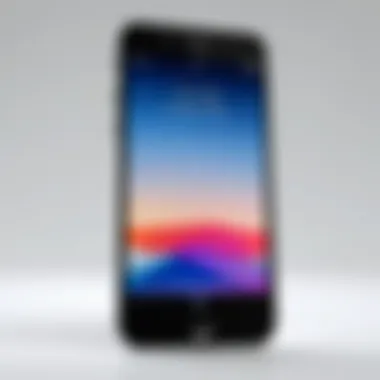
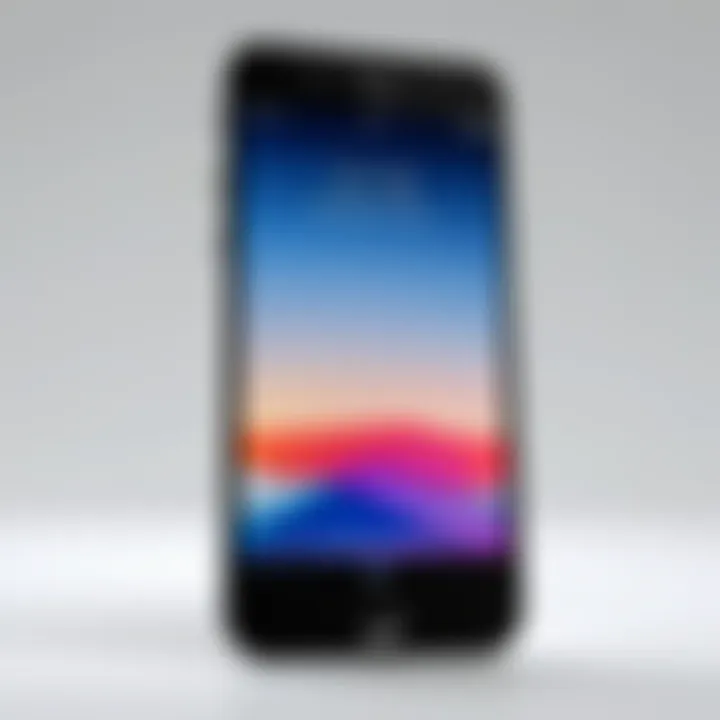
Intro
The Apple iPhone, a device that has redefined the smartphone landscape since its inception in 2007, continues to capture the attention of both consumers and industry experts. In this article, we will closely examine the pivotal features and innovations that make the iPhone stand out in a crowded market. Its influence is profound, shaping consumer trends and standards in technology. The goal is to provide IT professionals and tech enthusiasts a detailed, accurate understanding of the iPhone's evolution, its performance metrics, and its overall impact.
Features Overview
Apple's smartphones showcase a range of features that cater to various user preferences.
Key Specifications
The latest models of the iPhone include impressive specifications:
- Processor: The A15 Bionic chip, known for superior processing capabilities.
- Display: Retina display with ProMotion technology for smoother scrolling.
- Camera: Advanced camera systems with computational photography for high-quality images.
- Battery Life: Extended battery duration promoting all-day use.
Each specification represents a convergence of design and technology, ensuring that users have a satisfying experience.
Unique Selling Points
Apple differentiates its smartphones from competitors through several unique selling points:
- iOS Ecosystem: A tightly integrated operating system that ensures smoother user experience.
- App Store Quality: High standards in app approval leading to more reliable applications.
- Privacy Features: Enhanced focus on user privacy sets Apple apart in the market.
- Design and Build Quality: Premium materials and aesthetic appeal that reflect luxury and durability.
These selling points suggest that each model targets specific consumer needs while maintaining Apple's brand integrity.
Performance Analysis
To truly appreciate the iPhone, an analysis of its performance in real-world scenarios is vital.
Benchmarking Results
Recent benchmarking data reveals that the iPhone consistently performs at the top of various tests:
- CPU Performance: iPhones often outperform competing devices in tasks that require complex calculations.
- Graphics Performance: High frame rates in games and applications place the iPhone among the best available.
- App Launch Times: Quick loading times enhance user experience significantly.
Real-world Scenarios
In daily use, iPhones demonstrate their capabilities across numerous activities:
- Multitasking: Seamless transition between applications.
- Battery Efficiency: The ability to last through intensive use without issue.
- Camera Use: Exceptional images captured in a variety of conditions, showcasing features like night mode.
"The Apple iPhone remains an industry leader not just based on features but also its reliable performance in real-world applications."
Considering these factors, it is evident that the iPhone continually evolves to meet and exceed user expectations. The interplay of design, specifications, and performance fosters a user-centric approach that is critical in today's fast-evolving marketplace.
Intro to the Apple iPhone
The introduction of the Apple iPhone marked a pivotal moment in mobile technology. Its significance extends beyond mere hardware. The iPhone embodies a shift in how we interact with technology, influencing not only the smartphone market but also lifestyle, communication, and even etiquette. This section examines two critical aspects: the historical context of the iPhone's launch and its enduring significance in the mobile market.
Historical Context
The iPhone was first unveiled by Steve Jobs in January 2007, a blend of cutting-edge design and functionality. Prior to this launch, mobile phones prioritized calls and texts. The iPhone introduced a touch-based interface combined with robust software capabilities, setting a new benchmark. Its launch followed a period marked by gradual improvements in mobile technology, yet no device had effectively unified phone, internet, and media player into a single handheld unit. The iPhone's design aesthetic and intuitive usability attracted a wide audience, leading to its immediate success. The combination of Apple's pre-existing ecosystem, including iTunes and the iPod, positioned the iPhone advantageously within a technology-hungry consumer base.
Significance in the Mobile Market
The impact of the iPhone on the mobile market cannot be overstated. It holds a unique position, often seen as the gold standard for smartphones. The introduction of the App Store in 2008 facilitated a new economy for app developers, radically expanding mobile application availability and innovation. The iPhone also spurred competition among manufacturers. Companies like Samsung and Google had to innovate rapidly to keep pace. As a result, smartphones became more than tool; they transformed into essential components of daily life.
"The iPhone redefined the smartphone landscape, influencing design, functionality, and consumer expectations."
In summary, the iPhone is central to understanding not only Apple's strategy but also the evolution of the smartphone itself. Its historical launch and ongoing influence underscore the need for a thorough exploration of its features, innovations, and the market dynamics it has shaped.
Overview of Recent iPhone Models
Understanding the recent iPhone models offers vital insights into Apple's strategic approach within the mobile market. Each new release not only showcases enhancements in technology and design but also reflects market trends and consumer demands. This section delves into the different iPhone model variants available today, along with their key specifications, elucidating how these elements contribute to the overarching significance of the iPhone in the tech landscape.


iPhone Model Variants
Apple has consistently diversified its iPhone lineup to cater to various segments of the market. The recent models include the iPhone 15, iPhone 15 Pro, and iPhone 15 Pro Max. These variants are not merely cosmetic enhancements; each model incorporates distinct features that appeal to different user preferences.
- iPhone 15: This standard model typically offers a balanced performance suitable for everyday use. With a high-quality display and robust camera capabilities, it remains an attractive choice for the average consumer.
- iPhone 15 Pro: Aimed at professionals and enthusiasts, this model often includes advanced materials, such as surgical-grade stainless steel case, and enhanced camera systems. The focus is on providing superior performance and capabilities in a compact form.
- iPhone 15 Pro Max: This represents the premium offering. It includes the largest display and often the best camera functionalities, particularly appealing to those who prioritize media consumption and photography.
This model differentiation allows Apple to address a wider audience, ensuring they remain competitive in the market by catering to various price points and feature sets.
Key Specifications
Specifications are essential to evaluating the iPhone's performance and capabilities. The recent models often highlight Apple’s cutting-edge engineering prowess. Some key specifications worth mentioning include:
- Processor: The latest iPhone series features the A17 Bionic chip, known for its speed and efficiency. This chipset enables seamless multitasking and enhanced gaming experiences.
- Camera System: Upgrades in optical zoom and image processing software make the photography experience exceptional. Features like Night mode and Deep Fusion on recent models have positioned the iPhone as a leader in mobile photography.
- Display: The Super Retina XDR display provides vivid colors and high brightness, enhancing the viewing experience whether for work or entertainment.
- Battery Life: Apple continues to improve battery tech, with recent models boasting longer usage times thanks to energy-efficient components and software optimizations.
In summary, the recent iPhone models not only offer innovation but also embody an understanding of market demands and consumer behavior. By systematically evaluating both model variants and their specifications, one can appreciate the iPhone's role in influencing the smartphone industry.
Each new iPhone model not only marks a technological progress but also sets new standards for mobile devices across the market.
Technological Innovations
The importance of technological innovations in the context of the Apple iPhone cannot be overstated. These innovations have not only defined the capabilities of the device but have also influenced the broader smartphone market. Understanding these advancements offers IT professionals and tech enthusiasts insights into how the iPhone maintains its competitive edge. Key elements such as camera enhancements, chipset advancements, and improvements in battery life and efficiency deserve special attention. Through examining each of these components, it becomes clear how they contribute to the overall user experience while also setting industry standards for performance and functionality.
Camera Enhancements
The camera system in iPhone models has seen remarkable improvements over the years, often serving as a primary selling point for many consumers. Recent iterations, like the iPhone 14 Pro, integrate advanced features such as multiple lenses, computational photography, and enhanced low-light performance.
- Multiple Lenses: With wide, ultra-wide, and telephoto lenses, users can take a wider range of photos with different perspectives, increasing creative potential.
- Computational Photography: This technology allows the camera to utilize machine learning algorithms to enhance images. Features like Night mode and Deep Fusion result in stunning quality in varying conditions.
- Low-Light Performance: Significant strides have been made in reducing noise and increasing clarity. This change is highly relevant for the modern user, who captures real-life moments at any time of day.
Apple’s focus on camera technology is not only about satisfying consumer demand but also about setting a benchmark for competitors. Each enhancement reaffirms Apple's commitment to delivering outstanding photographic capabilities.
Chipset Advancements
The chipset is the heart of the device, determining performance, speed, and efficiency. Apple's in-house silicon, like the A16 Bionic chip in the latest models, reflects a significant leap in technology.
- Performance: The A16 Bionic offers up to 6 core CPU performance and 5 core GPU performance. This results in smoother multitasking, high-resolution gaming, and resource-heavy applications running without lag.
- Energy Efficiency: One crucial focus area is power consumption. With advancements in architecture, these chips can perform at high speeds while using less energy, thus improving battery longevity.
- Machine Learning: Built-in machine learning capabilities in these chipsets have enabled better image processing, voice recognition, and overall system responsiveness. It offers users an intuitive experience that adjusts based on usage patterns.
Chipset advancements are pivotal, as each iteration not only enhances user experience but also sets a technological precedent, making other brands work towards similar innovations.
Battery Life and Efficiency
In the realm of mobile technology, battery life remains a critical factor influencing consumer choice. Apple's approach to optimizing battery life is multi-faceted, engaging both hardware and software.
- Battery Capacity: Over the years, the physical battery capacity has increased in newer iPhone models. However, it is the combination with software optimizations that has led to impressive longevity.
- Software Management: iOS features adaptive battery management that learns usage patterns and conserves energy accordingly. It’s a smart approach that provides users with more screen time without necessitating more frequent charges.
- Fast Charging and Wireless Capabilities: Support for fast charging has improved the overall user experience. Charging speeds are now significantly quicker, and wireless charging offers additional convenience.
Focusing on battery life and efficiency is increasingly important for users who rely on their devices throughout the day. Innovations in this field show Apple's dedication to meeting consumer needs without sacrificing user satisfaction.
"The iPhone’s evolution in technological innovations illustrates Apple’s commitment to redefining user experience and performance standards."
Understanding these technological innovations can empower consumers and professionals alike to appreciate the Apple iPhone's place in the market. The continuous advancements not only keep Apple at the forefront but also shape expectations for future smartphones.
User Experience and Interface
The user experience and interface of the Apple iPhone are critical elements that define its value and success in the smartphone market. As technology evolves, users increasingly seek devices that are not only functional but also provide a seamless and enjoyable experience. The iPhone’s design philosophy prioritizes intuitive interaction, which is essential for maintaining user engagement. Throughout the years, Apple has refined the interface and user experience, focusing on simplicity and efficiency while incorporating advanced technological features.
Operating System Features
At the heart of the iPhone's user experience lies the iOS operating system. iOS is designed for smooth operation and integration with the hardware. One of the standout features is its clean and straightforward interface. Navigating through apps is user-friendly. Additionally, updates to iOS often introduce new functionalities such as improved multitasking capabilities, enhanced notifications, and deeper integration with Siri.
For example, the App Library feature automatically organizes apps into categories, making it easier for users to find what they need without scrolling through numerous pages. This organizational method minimizes clutter and enhances usability, allowing users to focus more on their tasks.
Moreover, the customizable Control Center permits users to access vital settings quickly. This feature reflects Apple’s commitment to providing both a customizable and intuitive experience. The focus on security and privacy in iOS also builds a trust-based relationship with users. The frequent updates provide latest security patches, which reinforces the operating system's robustness and reliability.
Usability and Accessibility
Usability is essential in determining how effectively users can interact with their devices. iPhone's design considers various user needs. For instance, features such as VoiceOver provide significant assistance for users with visual impairments. This screen reader offers auditory feedback and braille display compatibility, promoting inclusivity.
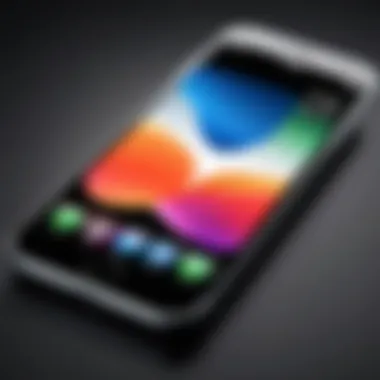
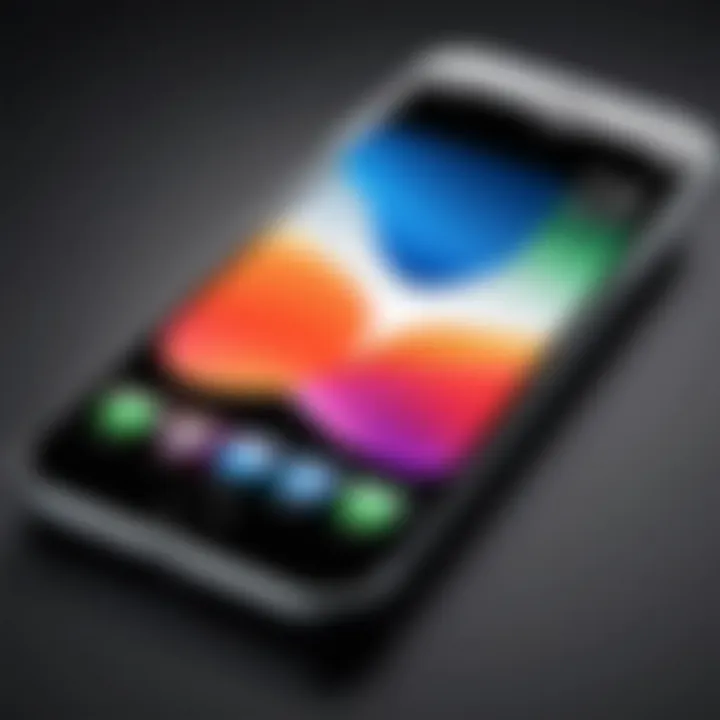
Furthermore, Apple includes accessibility options like Magnifier and Color Filters, which enhance the user experience for those with different requirements. These design aspects demonstrate the brand’s dedication to all users, ensuring that the iPhone remains approachable and usable for a diverse demographic.
In addition, the tactile feedback provided by the haptic engine is notable. It adds a joyful dynamism to interactions. This technology enhances the experience, making it more immersive. Another example is the Siri Shortcuts feature, which allows for personalized commands to streamline repetitive tasks. Quick access to frequently used actions improves overall efficiency for users.
"Apple's focus on user experience elevates the iPhone beyond a phone, making it essential in daily life for many."
The combination of iOS features and usability options sets a standard in mobile technology. The philosophy behind iPhone's interface portrays a balance of modern design with practical usability that appeals to a wide range of users.
Competing Devices in the Market
The landscape of the smartphone market features a myriad of devices, with the Apple iPhone being one of the most prominent. Understanding the competition is of crucial importance for grasping the iPhone's position and strategy within this vibrant ecosystem. This section delves into the key elements that define the competition between iPhone and its rivals, primarily focusing on Android devices. By examining this competitive environment, IT professionals and tech enthusiasts can better appreciate the complexities of consumer choices and technological developments.
Comparison with Android Devices
Android devices represent the predominant category of competitors to the iPhone. The similarities and differences between these two platforms can significantly influence consumer preferences.
- Operating System: The iPhone operates on iOS, known for its user-friendly interface and optimized performance. In contrast, Android operating systems, developed by Google and several other manufacturers, offer greater customization. This flexibility can appeal to users who desire control over their device experience.
- Hardware Variability: While iPhones come with standardized hardware configurations, Android devices provide a wide array of choices. Different manufacturers like Samsung, Google, and OnePlus offer various specifications within their models, catering to different price points and usage scenarios. This range gives consumers many options to select based on personal needs.
- Ecosystem Integration: Apple’s ecosystem is a significant advantage. Users benefit from seamless integration between their iPhones and other devices such as iPads, Macs, and Apple Watches. Android devices may struggle to match this level of harmony, as the ecosystem can be fragmented due to various manufacturers and software versions.
- Security and Updates: iOS is often perceived as more secure than many Android devices, mainly due to the controlled nature of its app store and the swift updates it receives. In comparison, the Android landscape can face fragmentation issues, where not all devices receive timely security patches.
"The competitive dynamics between iPhone and Android devices illustrate how consumer preferences shape technological advancements across the industry."
Market Position Analysis
The iPhone's market position remains robust, thanks in part to its brand loyalty and consistent innovation. It commands a significant share of the premium smartphone segment, often seen as a status symbol. Analyzing its market position reveals several critical insights:
- Sales Performance: Apple frequently leads in sales revenue, often outperforming its competitors in the high-end market. Despite the growth of Android vendors, Apple's ability to maintain higher average selling prices has contributed to its dominance.
- Market Strategy: Apple focuses on a premium branding strategy, emphasizing quality over quantity. By providing unique features and exclusive services, such as iMessage and Apple Pay, it differentiates itself from Android competitors.
- Global Influence: The iPhone’s influence extends beyond hardware specifications. It impacts consumer expectations, shaping what features are deemed essential in new smartphone releases.
In sum, understanding the competitive devices in the market is essential for grasping the true significance of the iPhone. The challenges posed by Android devices highlight the need for ongoing innovation and strategic positioning to maintain competitiveness.
Software Ecosystem Supporting the iPhone
The software ecosystem surrounding the Apple iPhone is a crucial component of its success. It encompasses the operating system, applications, and third-party integrations that work together to create a seamless user experience. This ecosystem facilitates not only the functionality of the device but also its continuous improvement and relevance in a fast-evolving market.
A well-structured software ecosystem fosters innovation, enhances user engagement, and contributes to customer satisfaction. IT professionals and tech enthusiasts must appreciate these elements to fully understand the iPhone's dominance in the smartphone arena.
App Store Dynamics
The App Store is central to the iPhone's software ecosystem. Launched in 2008, it has since transformed how users interact with their devices. The App Store provides access to millions of applications across various categories. Gamification of the user experience is one effect of having a rich variety of apps.
From productivity tools to entertainment, the App Store enables developers to reach consumers effectively. This distribution platform allows developers to innovate. It leads to a competitive environment where users benefit through regularly updated apps. The App Store's revenue model favors quality apps and responsible monetization.
Some key aspects of App Store dynamics include:
- Rigorous Review Process: Apps undergo a stringent review process to ensure that they meet Apple's quality standards. This contributes to a polished user experience.
- Regular Updates: The platform enables developers to provide updates, ensuring that applications remain relevant and functional with each iPhone iteration.
- User Feedback: Users can contribute to app development through reviews, guiding developers on what improvements are desired or bugs that need fixing.
The App Store's influence on app quality and user engagement is significant. It helps maintain Apple's premium market status.
Third-party Applications and Integrations
Third-party applications complement Apple's native offerings. They enhance the functionality of the iPhone and create unique user experiences. Integration with various services is vital to broaden the iPhone's capabilities.
This integration often involves APIs that allow developers to connect their apps with existing services. For instance, many popular apps like Spotify and Zoom leverage such integrations for seamless functionality. This accessibility is appealing to developers and users alike.
Factors that underline the importance of third-party applications include:
- Increased Utility: Users can customize their devices according to their preferences. This customization enhances user satisfaction, as diverse applications cater to different needs.
- Innovation: Third-party developers innovate continuously, offering solutions that Apple may not have considered initially. This competitive landscape pushes the boundaries of what's achievable on a smartphone.
- Market Growth: By allowing third-party applications, Apple enables a growing market that has a direct impact on device sales and user retention.
Overall, the software ecosystem supporting the iPhone is instrumental in its continued relevance. From the App Store's dynamics to third-party applications, every element plays a role in enhancing the user experience and maintaining competitive advantage.
Consumer Adoption and Behavior
Understanding consumer adoption and behavior regarding the Apple iPhone is vital for grasping how this device maintains its dominant position in the smartphone market. This section examines key elements such as user demographics, brand loyalty, and consumer trust. These factors not only influence purchasing decisions but also shape the overall perception of the product in a competitive landscape.
Demographics of iPhone Users

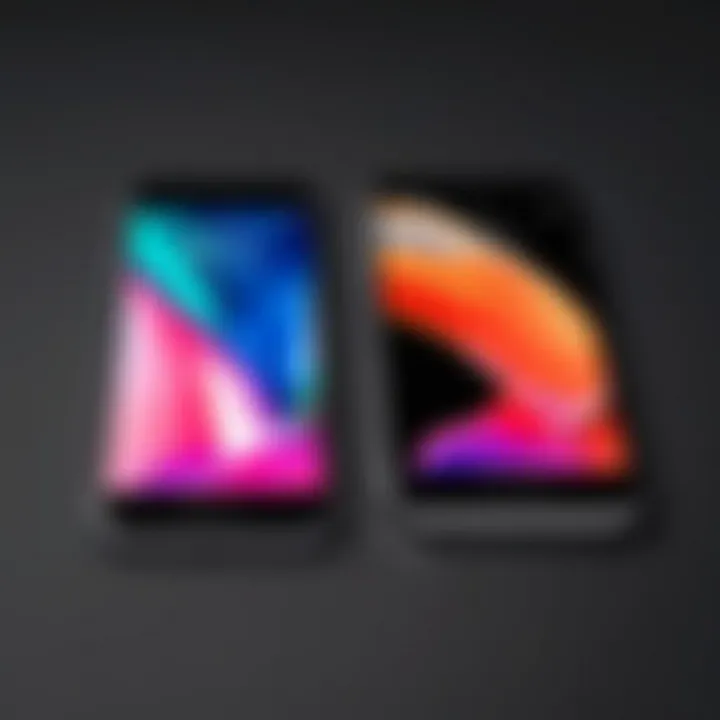
The demographics of iPhone users provide crucial insight into the types of customers who prefer this brand over others. Typically, iPhone users are often younger, more affluent, and tend to inhabit urban areas. According to various studies, individuals aged between 25 to 34 years are among the largest segments of iPhone users. This group is often characterized by their willingness to invest in premium devices, seeing them not only as communication tools but as status symbols.
Moreover, the educational background of iPhone users also skews positively; many tend to have higher education degrees. This correlation suggests that users may prioritize technology that offers both functionality and prestige. Understanding these demographic characteristics is essential for businesses aiming to market complementary products or services.
Brand Loyalty and Consumer Trust
Brand loyalty plays a significant role in the continued success of the Apple iPhone. Many consumers exhibit a remarkable affinity toward the brand, often displaying a willingness to upgrade to newer models regularly. Various studies indicate that a large percentage of existing iPhone users remain loyal to the brand when considering their next smartphone purchase.
Factors that contribute to this loyalty include:
- User Experience: The intuitive operating system and seamless integration with other Apple products enhance the value proposition.
- Quality and Performance: Consistent performance across devices reassures consumers about the longevity and reliability of the iPhone.
- Social Identity: Many users associate the iPhone with a specific lifestyle and status, influencing their choice to stick with the brand.
This strong sense of loyalty translates into sustained market share for Apple, even amidst fierce competition from Android devices. Trust in Apple as a brand bolsters consumer confidence, which is essential in a market increasingly sensitive to security and privacy concerns. In summary, understanding consumer behavior surrounding the Apple iPhone is essential in predicting future trends, market shifts, and the overall impact of technological advancements on purchasing decisions.
Sustainability and Ethical Considerations
As the tech industry faces increased scrutiny over environmental and ethical practices, the sustainability and ethical considerations surrounding the Apple iPhone have become more prominent. Apple's commitment to sustainability impacts both consumer perceptions and the overall market landscape. Focusing on this topic illustrates how the iPhone's lifecycle affects the environment and the social ramifications of its production.
Environmental Impact
Apple has taken steps to assess and reduce the environmental footprint of its products. The company has set ambitious goals to achieve carbon neutrality across its entire supply chain by 2030. This commitment includes reducing waste, increasing energy efficiency, and sourcing sustainable materials.
- Carbon Footprint Reduction: Apple's extensive efforts in renewable energy initiatives have significantly lowered the carbon emissions associated with the manufacturing and transportation of its products.
- Material Sourcing: The usage of recycled materials in iPhones, such as recycled aluminum and rare earth elements, directly reduces the need for mining, which can be environmentally degrading.
However, critics argue that the impact of e-waste remains significant. Consumers replace their devices frequently, contributing to large amounts of trash. This aspect raises concerns about disposal and recycling programs. Apple's recycling initiatives, like the Daisy robot, help recover valuable materials from old iPhones, yet the scale of the issue demands a broader industry-wide solution.
Supply Chain Transparency
Transparency in supply chains is essential for building consumer trust. Apple has made notable improvements in this area, releasing annual reports detailing its supply chain practices. These documents outline efforts to ensure labor rights, safety, and fair treatment of workers involved in manufacturing.
- Supplier Responsibility Program: Apple engages in a rigorous vetting process for suppliers, focusing on ethical labor practices and compliance with environmental standards. The company has also established programs to educate suppliers on these practices.
- Audit and Accountability: Regular audits are performed to ensure adherence to Apple's strict standards. Results are shared publicly, which is a step towards accountability but also invites further scrutiny.
Despite these efforts, questions remain about conditions in some factories, and ongoing transparency efforts are crucial for consumer confidence. The success of sustainability measures ultimately relies on long term consumer awareness and pressure for continuous improvement.
"Apple's journey towards sustainability is crucial not just for their brand, but for the future of the tech industry."
Future of the Apple iPhone
The discussion about the future of the Apple iPhone is crucial for understanding the trajectory of mobile technology. The iPhone has consistently set trends in the smartphone industry, influencing both hardware and software development. As technology evolves, so does the expectation from consumers.
Apple must navigate numerous factors to maintain its competitive edge. The focus will be on sustainability, user-centered innovations, and integration of cutting-edge technologies like augmented reality. This section explores anticipated advancements and their potential implications.
Predictions for Upcoming Models
The future iPhone models are likely to reflect a response to current market demands and technological advancements. Here are some predictions based on recent trends:
- Enhanced Camera Systems: Future models may include multi-lens setups that further push boundaries in photography and videography. This is an area where Apple has consistently made significant improvements.
- Improved Battery Technology: As user demand for longer-lasting devices increases, innovations in battery technology, including solid-state batteries, could be implemented. This would not only extend battery life but also enhance safety.
- Foldable Design Considerations: While Apple has been conservative about foldable technology, future models might explore this design. A foldable iPhone could appeal to consumers looking for versatile devices.
- Integration with Smart Home Technologies: As the trend towards smart homes grows, iPhones may function as more central control hubs for smart devices. Strengthening connections with HomeKit could streamline user experiences.
Technological Trends and Innovations
Several technological trends are likely to shape the future of the iPhone. These innovations reflect both market demands and Apple’s strategic focus:
- 5G Expansion: As 5G networks become more widespread, future iPhones will utilize this technology to enhance data speeds and reliability. Increased adoption of augmented reality applications will depend heavily on this fast connectivity.
- Artificial Intelligence Integration: The use of machine learning algorithms is likely to improve personalization features, offering users a more tailored experience. Siri's capabilities may expand significantly.
- Sustainability Initiatives: There is an increasing emphasis on environmentally-friendly practices. Future iPhones may be made from recycled materials, with a focus on reducing carbon footprints across their production chain.
- Health Monitoring Features: With a growing trend in health awareness, integration of more advanced health monitoring sensors could emerge, making iPhones essential for health tracking in daily life.
The evolution of the iPhone is not just about new features; it is about setting new standards in the smartphone industry and adapting to a rapidly changing technological landscape.
By analyzing these predictions and trends, it becomes clear that the iPhone will continue to be a pivotal player in shaping mobile technology's future, offering both opportunities and challenges for Apple moving forward.
End
The analysis above highlights the strengths and weaknesses of the Apple iPhone. Its technological advancements such as camera enhancements and chipset developments create a significant advantage. This leads to better consumer experiences and increased brand loyalty. Understanding these elements is vital for IT professionals and tech enthusiasts. The market impact of the iPhone is profound, shaping industry standards and influencing competitor strategies. This article serves to provide a comprehensive vision of how the iPhone continues to evolve and maintain its dominant position in the smartphone arena.
Recap of Key Insights
Throughout the article, the following key points emerge:
- The iPhone's historical significance in the mobile landscape is undeniable. It marked a turning point in smartphone design and functionality.
- Recent models exhibit remarkable technological innovations, particularly in camera quality and processing power.
- The software ecosystem, with the App Store and third-party applications, bolsters the value of owning an iPhone.
- Consumer behavior indicates strong brand loyalty, which is essential for Apple's marketing strategies.
- Ethical considerations and sustainability efforts have become increasingly relevant, as consumers desire companies to be responsible.
Final Thoughts on the iPhone's Role in Tech
In summary, the iPhone has become more than just a device; it represents a cultural shift in technology usage. As it adapts to technological trends, it influences user expectations and industry norms. Apple continues to push boundaries, making the iPhone a significant player in the tech world. IT professionals should monitor its developments closely to understand not just consumer behavior, but also the evolving technological landscape that the iPhone embodies.



